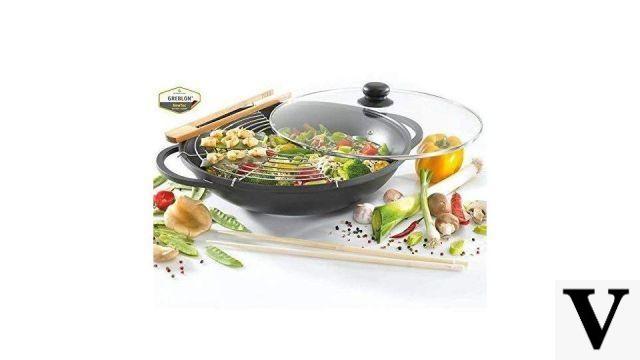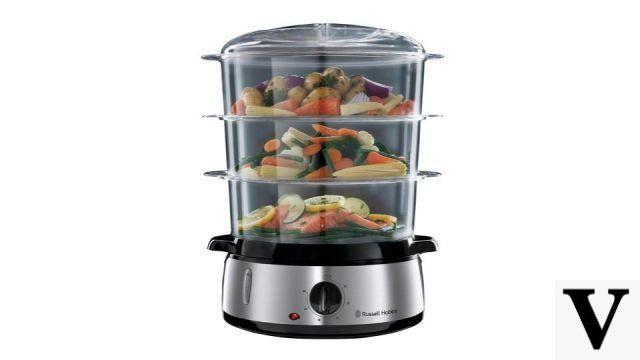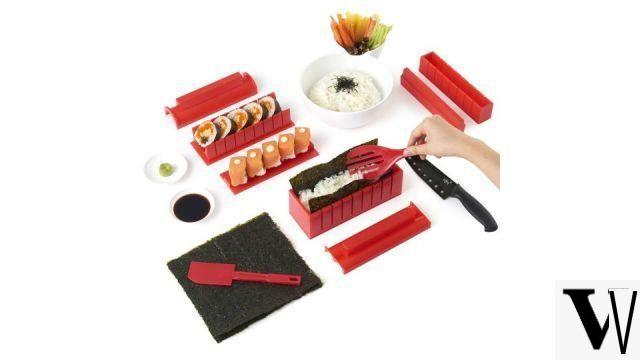by
The exotic charm of chopsticks and rolls of rice conquers the country of the Mediterranean diet, which opens the frontiers of its cuisine to the flavors that come fromNibujon. Chinese restaurants are also multiplying with us Sushi bar, while on supermarket shelves they appear more and more frequently soy noodles, spices exotic, Japanese and Korean vegetables.
Taste gains. But the health? We asked two experts. Which in these pages guide us to discover the dishes and ingredients that are allied to ours welfare.
Discover the benefits of eating Japanese & co.
It is no coincidence that i Japanese they are the longest-lived in the world, and also the thinnest, along with their Korean neighbors. "The cuisine of the Rising Sun is low-calorie, calibrated and complete, because the dishes always combine carbohydrates, proteins and vegetables in the right proportions ", explains Andrea Calvo, graduate in gastronomic sciences, food technician and educator, expert in Asian nutrition.
"The fish abounds, from tuna to salmon: it is source of Omega 3 fatty acids, which protect the heart and brain ”, explains the doctor Diana Scatozza, dietician in Milan. "There soyInstead, it is rich in isoflavones, which has positive effects on cardiovascular and bone health. While the seaweed (nori, kombu and wakame) provide proteins, minerals, good fats and vitamins. A sushi lunch it is a balanced and light choice, which can be repeated several times a week ».
While the Japanese prefer cold dishes, the Chinese cooking focus on steaming or cooking in the wok, the typical hemispherical pan, which requires the addition of oil. «The share of lipids consequently increases, also because the menu includes many fried and a large use of meat of pig», Underlines the expert.
La Korean cuisine is a mix of the two: it combines the basic foods of the Rising Sun gastronomy (rice, fish, seaweed) with typically Chinese cooking and preparation techniques. It is characterized by the use of fermented foods, like kimchi (we talk about it here on the right) and for the intense flavor of the dishes, due to the use of spices and chilli.
Wok: never again without

The wok is a pan that cannot be missing if you want to prepare dishes from the oriental cuisine. In fact, thanks to the wok, you can keep the vegetables perfectly crunchy and toss them together with other tasty ingredients. From chicken to fish. Choose it quality, so not having to add fat during cooking and therefore enjoy all the benefits of Japanese cuisine (and more). This has a diameter of 39 cm and is equipped with many accessories to test your creativity: a tempura grill, wooden tongs and chopsticks. However, do not use it on induction hobs.
The electric steamer: for a light kitchen

La steaming is one of the advantages of Japanese cuisine. In fact, this type of cooking food keeps them nutritional properties (vitamins, minerals, antioxidants) and also the totally intact taste. This model is electric and multi-storey. Plus, it has a 60-minute sleep timer and BPA-free tubs. This also means a notable saving of time and the ability to cook a complete meal at once. Ideal for the whole family, for delicious but healthy lunches and dinners. Remember to follow the principles of oriental cuisine also for arranging food on the various shelves.
Kit per sushi

Sushi is now one of the Japanese foods most loved by young and old. Furthermore, it is a light food and also suitable if you are on a diet. Obviously, to prepare sushi you need very fresh raw materials and the fish must be treated in such a way as to eliminate any type of contamination. You can also prepare it at home, making everyone happy. This kit per sushi it's easy and fun to use. In addition it is really complete: it includes, in fact, well 11 pieces plus a special fish knife. You will be able to prepare sushi of all shapes; round, square and even a little heart! Children will also have a great time and will begin to enjoy different types of cuisine.
Order the dishes in the right sequence
"In Japanese restaurants it is a good habit to open the meal with a saucer of edamame, small soy beans: while waiting for the dishes to arrive, they break hunger with very few calories and in addition provide amino acids, minerals (especially iron), vitamins and fibers », advises Andrea Calvo.
«As" first ", ok to one soup, which has an excellent satiating power and is complete with everything: cereals, proteins and vegetables. For "second" i are perfect sashimi (sliced tuna, salmon or sea bass, served without condiments) or the tartare, always raw fish, perhaps with a side dish of mushrooms, seaweed or cabbage.
Turning to the famous rolls, the simplest is the nigiri (the oval of rice with a slice of fish on top), which provides 35 to 80 calories per piece. Follow the sushi roll, vegetarian or fish: they give from 20 to 80 calories, depending on the filling ».
Whatever type of cuisine you choose, fried foods should be limited, such as Chinese spring rolls (crispy pastry wraps stuffed with meat and vegetables) or the famous agemono di tonkatsu giapponese: a pork cutlet cooked in boiling oil and served in strips.
«Order only one fried per meal e no more than once or twice a week: it affects the line, raises the cholesterol and triglyceride values and is heavy to digest », warns Diana Scatozza.
Pay attention not only to quantities
"Although the portions served are generally small, the excuse of sharing dishes with friends and colleagues sometimes leads to ordering more than necessary », says Andrea Calvo. «It should be emphasized that the rice is added with sugar and vinegar and this raises the caloric share. Don't overdo it with either soy sauce, left on the table to dip the dishes. Although it has far fewer calories thanextra virgin olive oil (just 6 for 10 g, compared to 90 for our local age), it is rich in salt ». Finally, pay attention to the risks associated with allergic reactions.
«It is essential to read the ingredients of the dish on the menu, checking if there are any potential allergens such as soy, prawns, sesame, all widely used in oriental cuisine ”, explains the dietician. "Not only that: who has thyroid problems, for example, it must limit the intake of algae ».
Learn to recognize the ok premises
The restaurants of the Rising Sun are many: more than 400 in Milan alone, but the authentic ones are less than fifty throughout the country. A list, although not exhaustive, can be found on the website of the Association of Japanese restaurateurs in the country .
"In a" real "restaurant, the chef or one of the owners is a native of the country whose cuisine he proposes, he knows the gastronomic tradition, raw materials and preparation techniques », Andrea Calvo points out. The "key" element to evaluate an oriental restaurant is always the menu.
“Authentic Japanese has it in the paper a limited number of dishes, prefers blue fish, a few prawns and, if it is a high quality restaurant, also the tuna belly. She is also revealing the establishment: the chopsticks must be placed in front of the plate and not between the plate and the glass ”, explains the expert.
"The restaurant Korean doc, on the other hand, it offers many vegetables (spicy, fermented, spicy) and vegetarian recipes. While in the list of the true Chinese there are many soups and at least one stewed duck (in the top places you can find up to 3 or 4 different preparations) ».
Finding the right place is also essential to have a true experience of Asian cuisine: the “washoku”, the traditional Japanese cuisine, was recognized in 2013 by Unesco as an intangible cultural heritage of humanity.
To avoid being disappointed it is important to inquire about history of the place: how long has it been open, how popular is it. "Online customer reviews are useful when accompanied by photos," says the expert. «For the rest, there is no official recognition for any oriental cuisine.
For years there has been talk of the arrival of a "blue stamp", wanted by the Tokyo government to protect the real Japanese restaurants in the world, but still not there." As for the Chinese and Korean restaurants, the problem has not even been raised.
Also take a look at hygiene and price
Better stay keep away from walking stalls: they do not offer sufficient guarantees of hygiene. While the restaurants that offer the formula should not be discarded a priori "all you can eat", with saucers offered on automatic rollers that you can take as many times as you want, at a fixed cost.
Just make sure that the swivel is equipped with refrigeration. «Even better if the kitchen is visible: it is an index of scrupulousness and transparency», says the expert. And if the dish is "worked" at the moment. The advice is especially true for the sushi: the real one is prepared with fish cut after ordering and paired with rice and seaweed at the last, so the flavors don't mix.
And what about the price? It's typically more affordable at lunchtime and set menus, but when it's too low you have to be wary. Another alarm bell: the speed of the service. «It means that the dishes are made with“ ready bases ”, for example with already sliced meat and vegetables», concludes the expert.
And if you want to try your hand at Far Eastern recipes, we recommend you below the healthiest foods which are marketed in the country. They were chosen by Andrea Calvo, who illustrates both the nutrients and the benefits for your well-being.


























